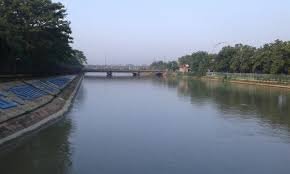Delhi’s green spaces get a major boost with eco-friendly connectivity initiative
In a significant move to enhance Delhi’s urban landscape, the Delhi Development Authority (DDA) has announced plans to interconnect several parks situated along the Yamuna floodplain through eco-friendly cycle tracks and pedestrian walkways. This green mobility initiative aims to not only promote sustainable transport but also encourage recreational use of the riverfront, while maintaining the ecological sanctity of the floodplain.
Seamless Access to Riverfront Parks
Currently, the Yamuna floodplain houses multiple large parks developed by the DDA such as Bansera, Asita East and West, Yamuna Vatika, Vasudev Ghat, and Amrit Biodiversity Park. Several new parks including Mayur Nature Park and the grand Yamuna Riverfront project near Sarai Kale Khan are also under development.
However, access to these parks has remained fragmented.
“Right now, people can enter Bansera or Asita, but cannot move from one park to another easily,” said Delhi’s Public Works Department (PWD) Minister Parvesh Verma. “We want a visitor who enters Asita Park near ITO to be able to enjoy all the green spaces along the river seamlessly — walking or cycling.”
A Sustainable Urban Vision
The DDA’s vision reflects the growing shift toward pedestrian-friendly, sustainable cities. The interconnected pathways — which will span across the 22-km stretch of the Yamuna — will allow uninterrupted movement for walkers, joggers, and cyclists along the riverbank.
Minister Verma emphasized that the project respects environmental restrictions in place on the Yamuna floodplain. “Construction is not allowed in most parts of the floodplain,” he explained. “So we’re exploring alternatives like jute paths and natural walkways that preserve the floodplain’s ecology while still achieving connectivity.”
Ecological Sensitivity Meets Urban Innovation
One of the key challenges in this initiative is balancing development with conservation. Since the Yamuna floodplain is an ecologically fragile zone, the DDA and PWD are working with environmental consultants to ensure that the tracks do not violate any environmental guidelines.
In a recent inspection, Delhi’s Lieutenant Governor V.K. Saxena reviewed the ongoing development at Asita Park. He highlighted the use of eco-friendly jute walkways and urged the DDA to replicate this model across other parks and even in forested areas like the Northern Ridge.
Officials close to the project stated that these jute pathways are not only environment-friendly but also cost-effective, permeable, and visually blend with the natural landscape.
Public Response and Civic Value
The announcement has drawn praise from urban planners and citizens alike.
“This is a fantastic initiative,” said Rajiv Malhotra, a resident of East Delhi and regular walker at Yamuna Vatika. “The river is finally becoming part of the city again. If we can walk or cycle along the river for kilometers, it’s not just good for health — it will change how Delhiites engage with nature.”
Environmentalists also lauded the plan. “Such low-impact infrastructure that connects people to green spaces is a big win,” said Ritu Mehra, an urban ecology researcher. “However, careful execution is key — we must ensure the floodplain isn’t disturbed by heavy footfall or improper construction.”
Part of a Bigger Push
This interlinking project is part of a broader strategy led by the Delhi LG to rejuvenate the Yamuna. Alongside park development, efforts are also underway to clean the river, improve sewage management, and relocate polluting industries.
The Yamuna Riverfront Development Project, one of the capital’s flagship urban renewal efforts, envisions a scenic and accessible waterfront akin to global models in Paris and London — but adapted to local conditions and climate.
A Greener Future for Delhi?
The interlinking of parks through cycle and walking tracks marks a fundamental shift in how Delhi views urban planning. It prioritizes wellness, sustainability, and access to nature — elements often overlooked in megacity development.
If implemented successfully, the initiative could not only reclaim the Yamuna as a civic space but also inspire similar ecological restoration and green connectivity efforts across other Indian cities.
As Delhi continues to battle pollution, congestion, and urban sprawl, projects like the Yamuna floodplain connectivity initiative offer a refreshing perspective. By integrating nature into daily urban life and creating sustainable alternatives to cars, the city is slowly carving a path toward a greener and healthier future.

